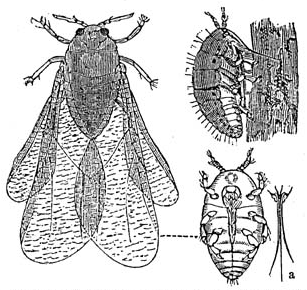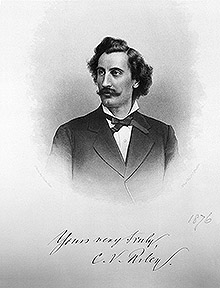
A vineyard is a plantation of grape-bearing vines, grown mainly for winemaking, but also raisins, table grapes and non-alcoholic grape juice. The science, practice and study of vineyard production is known as viticulture. Vineyards are often characterised by their terroir, a French term loosely translating as "a sense of place" that refers to the specific geographical and geological characteristics of grapevine plantations, which may be imparted to the wine itself.

Grape phylloxera is an insect pest of commercial grapevines worldwide, originally native to eastern North America. Grape phylloxera ; originally described in France as Phylloxera vastatrix; equated to the previously described Daktulosphaera vitifoliae, Phylloxera vitifoliae. The insect is commonly just called phylloxera.

In botany, chlorosis is a condition in which leaves produce insufficient chlorophyll. As chlorophyll is responsible for the green color of leaves, chlorotic leaves are pale, yellow, or yellow-white. The affected plant has little or no ability to manufacture carbohydrates through photosynthesis and may die unless the cause of its chlorophyll insufficiency is treated and this may lead to a plant diseases called rusts, although some chlorotic plants, such as the albino Arabidopsis thaliana mutant ppi2, are viable if supplied with exogenous sucrose.

Vitis riparia Michx, with common names riverbank grape or frost grape, is a vine indigenous to North America. As a climbing or trailing vine, it is widely distributed across central and eastern Canada and the central and northeastern parts of the United States, from Quebec to Texas, and eastern Montana to Nova Scotia. There are reports of isolated populations in the northwestern USA, but these are probably naturalized. It is long-lived and capable of reaching into the upper canopy of the tallest trees. It produces dark fruit that are appealing to both birds and people, and has been used extensively in commercial viticulture as grafted rootstock and in hybrid grape breeding programs.
A rootstock is part of a plant, often an underground part, from which new above-ground growth can be produced. It could also be described as a stem with a well developed root system, to which a bud from another plant is grafted. It can refer to a rhizome or underground stem. In grafting, it refers to a plant, sometimes just a stump, which already has an established, healthy root system, onto which a cutting or a bud from another plant is grafted. In some cases, such as vines of grapes and other berries, cuttings may be used for rootstocks, the roots being established in nursery conditions before planting them out. The plant part grafted onto the rootstock is usually called the scion. The scion is the plant that has the properties that propagator desires above ground, including the photosynthetic activity and the fruit or decorative properties. The rootstock is selected for its interaction with the soil, providing the roots and the stem to support the new plant, obtaining the necessary soil water and minerals, and resisting the relevant pests and diseases. After a few weeks the tissues of the two parts will have grown together, eventually forming a single plant. After some years it may be difficult to detect the site of the graft although the product always contains the components of two genetically different plants.

Hybrid grapes are grape varieties that are the product of a crossing of two or more Vitis species. This is in contrast to crossings between grape varieties of the same species, typically Vitis vinifera, the European grapevine. Hybrid grapes are also referred to as inter-specific crossings or "Modern Varieties." Due to their often excellent tolerance to powdery mildew, other fungal diseases, nematodes, and phylloxera, hybrid varieties have, to some extent, become a renewed focus for European breeding programs. The recently developed varieties, Rondo, and Regent are examples of newer hybrid grape varieties for European viticulturalists. Several North American breeding programs, such as those at Cornell and the University of Minnesota, focus exclusively on hybrid grapes, with active and successful programs, having created hundreds if not thousands of new varieties.

Hermann Jaeger was a Swiss-American viticulturist, honored as a Chevalier of the Legion of Honor for his part in saving the French wine industry from the phylloxera root louse pest.
Uhudler is a unique wine from Austria, which originates in the Südburgenland region. In appearance it is often a rosé colour, but is also made as a white wine. It has intense flavours of strawberry and black currants, a characteristic taste often called "foxy" in wine parlance. The grape varieties used are highly resistant to phylloxera and other diseases; as a result they do not often have to be sprayed with pesticides. They also require little fertilization because of their vigorous growth.
Alessandro Romeo Bragato (1859–1913) played a significant role in the development of the wine industry in Australia and New Zealand.

Jules Émile Planchon was a French botanist born in Ganges, Hérault.
Gros Verdot is a red French wine grape variety that was a historically important grape in the Gironde wine region of Bordeaux but plantings of the variety have been banned in the region since 1946 with the grape no longer being a permitted variety in any AOC Bordeaux wines.
Bouchalès or Grapput is a red French wine grape variety that is grown primarily in Bordeaux and Southwest France wine appellations. Plantings have declined in recent years as the vine has shown high sensitivity to downy mildew and black rot.
Couderc noir is a red wine hybrid grape that was formerly grown primarily in the South West France wine region and around the Gard département in the Languedoc-Roussillon region. The vine produces high yields and ripens late, creating a wine that is deeply colored with a distinct, earthy flavor. Couderc noir is normally used for mass commercial and table wines.

Pierre-Marie-Alexis Millardet was a French botanist and mycologist born in Montmirey-la-Ville.

The Great French Wine Blight was a severe blight of the mid-19th century that destroyed many of the vineyards in France and laid waste to the wine industry. It was caused by an aphid that originated in North America and was carried across the Atlantic in the late 1850s. The actual genus of the aphid is still debated, although it is largely considered to have been a species of Daktulosphaira vitifoliae, commonly known as grape phylloxera. While France is considered to have been worst affected, the blight also did a great deal of damage to vineyards in other European countries.
Château Pavie-Macquin is a Bordeaux wine from the appellation Saint-Émilion, ranked Premier grand cru classé B in the Classification of Saint-Émilion wine. The winery is one of three Pavie estates, along with Château Pavie and Château Pavie-Decesse, located in the Right Bank of France’s Bordeaux wine region in the commune of Saint-Émilion in the department Gironde. Having risen in esteem in the 1990s, it was promoted to Premier Grand Cru Classé in 2006.

Vitis berlandieri is a species of grape native to the southern North America, primarily Texas, New Mexico and Arkansas.
Colares is a Portuguese wine region centered on the Colares municipality in Estremadura region. The region has Portugal's highest wine classification as a Denominação de Origem Controlada (DOC). Located along the southwestern Atlantic coast, vineyards in the area are protected from the strong ocean winds by sandy dunes. In 1940s, vineyards covered 2,500 acres but have since been reduced by suburbanization to 50 acres. Between 1934 and 1994, only the local co-op could use the Colares appellation. Because grapevines there are grown directly upon the sand, and phylloxera aphids cannot live on sand, Colares vineyards are some of the only European vines that are not grafted upon American rootstocks. The ungrafted Ramisco vines of the Colares region are some of the oldest in Portugal. The region is known for its deep colored, full bodied red wines that are high in astringent tannins.
This glossary of viticultural terms list some of terms and definitions involved in growing grapes for use in winemaking.

The propagation of grapevines is an important consideration in commercial viticulture and winemaking. Grapevines, most of which belong to the Vitis vinifera family, produce one crop of fruit each growing season with a limited life span for individual vines. While some centenarian old vine examples of grape varieties exist, most grapevines are between the ages of 10 and 30 years. As vineyard owners seek to replant their vines, a number of techniques are available which may include planting a new cutting that has been selected by either clonal or mass (massal) selection. Vines can also be propagated by grafting a new plant vine upon existing rootstock or by layering one of the canes of an existing vine into the ground next to the vine and severing the connection when the new vine develops its own root system.












